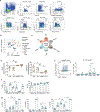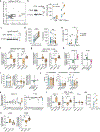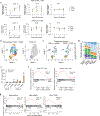Interferon subverts an AHR-JUN axis to promote CXCL13+ T cells in lupus
- PMID: 38987586
- PMCID: PMC11628166
- DOI: 10.1038/s41586-024-07627-2
Interferon subverts an AHR-JUN axis to promote CXCL13+ T cells in lupus
Erratum in
-
Publisher Correction: Interferon subverts an AHR-JUN axis to promote CXCL13+ T cells in lupus.Nature. 2024 Aug;632(8025):E6. doi: 10.1038/s41586-024-07845-8. Nature. 2024. PMID: 39060417 No abstract available.
Abstract
Systemic lupus erythematosus (SLE) is prototypical autoimmune disease driven by pathological T cell-B cell interactions1,2. Expansion of T follicular helper (TFH) and T peripheral helper (TPH) cells, two T cell populations that provide help to B cells, is a prominent feature of SLE3,4. Human TFH and TPH cells characteristically produce high levels of the B cell chemoattractant CXCL13 (refs. 5,6), yet regulation of T cell CXCL13 production and the relationship between CXCL13+ T cells and other T cell states remains unclear. Here, we identify an imbalance in CD4+ T cell phenotypes in patients with SLE, with expansion of PD-1+/ICOS+ CXCL13+ T cells and reduction of CD96hi IL-22+ T cells. Using CRISPR screens, we identify the aryl hydrocarbon receptor (AHR) as a potent negative regulator of CXCL13 production by human CD4+ T cells. Transcriptomic, epigenetic and functional studies demonstrate that AHR coordinates with AP-1 family member JUN to prevent CXCL13+ TPH/TFH cell differentiation and promote an IL-22+ phenotype. Type I interferon, a pathogenic driver of SLE7, opposes AHR and JUN to promote T cell production of CXCL13. These results place CXCL13+ TPH/TFH cells on a polarization axis opposite from T helper 22 (TH22) cells and reveal AHR, JUN and interferon as key regulators of these divergent T cell states.
© 2024. The Author(s), under exclusive licence to Springer Nature Limited.
Figures















Comment in
-
Unraveling the origins of pathogenic CXCL13+ helper T cells in systemic lupus erythematosus.Immunol Cell Biol. 2024 Oct;102(9):757-759. doi: 10.1111/imcb.12818. Epub 2024 Sep 1. Immunol Cell Biol. 2024. PMID: 39218440
References
MeSH terms
Substances
Grants and funding
- R01 AI165236/AI/NIAID NIH HHS/United States
- R01 AI176599/AI/NIAID NIH HHS/United States
- DP2 AI136599/AI/NIAID NIH HHS/United States
- P30 CA060553/CA/NCI NIH HHS/United States
- K08 AR072791/AR/NIAMS NIH HHS/United States
- R01 AR078769/AR/NIAMS NIH HHS/United States
- P30 AR075049/AR/NIAMS NIH HHS/United States
- P30 AR070253/AR/NIAMS NIH HHS/United States
- R01 AR073290/AR/NIAMS NIH HHS/United States
- P30 AI117943/AI/NIAID NIH HHS/United States
- F31 CA268839/CA/NCI NIH HHS/United States
- U54 AI170792/AI/NIAID NIH HHS/United States
LinkOut - more resources
Full Text Sources
Medical
Molecular Biology Databases
Research Materials
Miscellaneous

